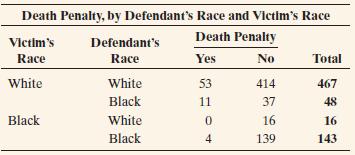Death penalty and race The table shows results of whether the death penalty was imposed in murder
Question:
Death penalty and race The table shows results of whether the death penalty was imposed in murder trials in Florida between 1976 and 1987. For instance, the death penalty was given in 53 out of 467 cases in which a white defendant had a white victim.

a. First, consider only those cases in which the victim was white. Find the conditional proportions that got the death penalty when the defendant was white and when the defendant was black. Describe the association.
b. Repeat part a for cases in which the victim was black.
Interpret.
c. Now add these two tables together to get a summary contingency table that describes the association between the death penalty verdict and defendant’s race, ignoring the information about the victim’s race. Find the conditional proportions. Describe the association and compare to parts a and b.
d. Explain how these data satisfy Simpson’s paradox.
How would you explain what is responsible for this result to someone who has not taken a statistics course?
e. In studying the effect of defendant’s race on the death penalty verdict, would you call victim’s race a confounding variable? What does this mean?
Step by Step Answer:

Statistics The Art And Science Of Learning From Data
ISBN: 9781292164878
4th Global Edition
Authors: Alan Agresti, Christine A. Franklin, Bernhard Klingenberg






